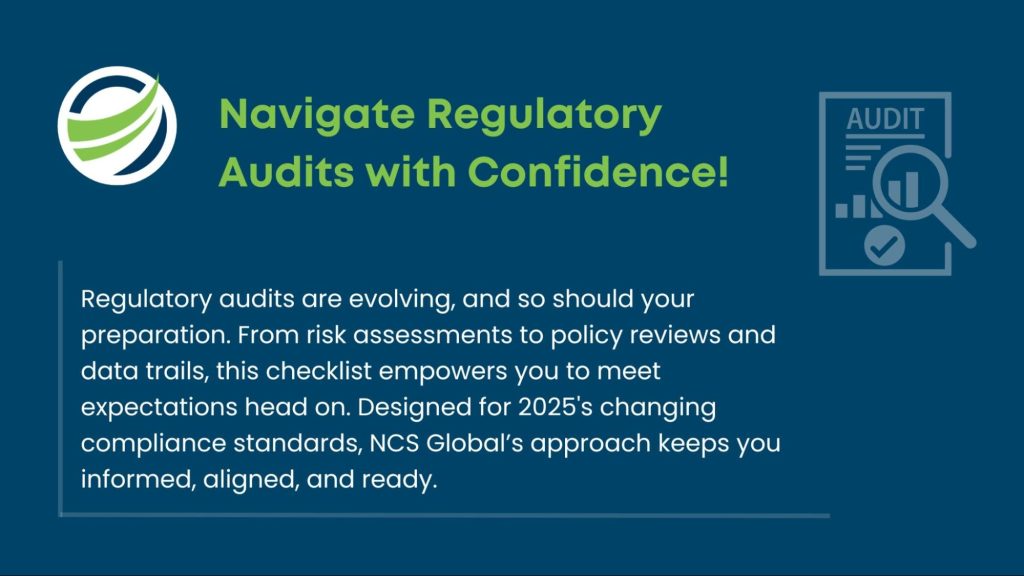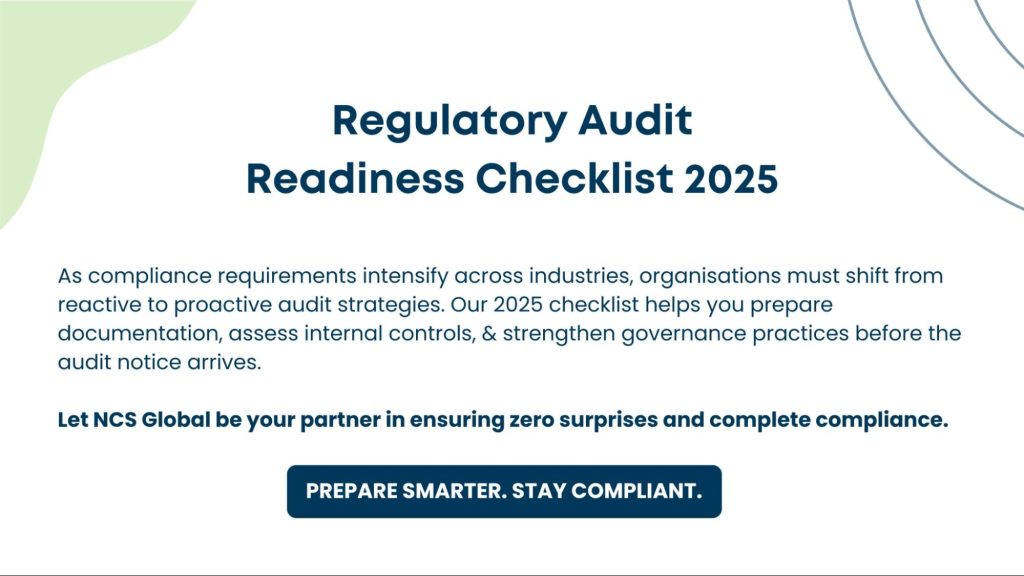- August 12, 2025
- by NCS Global
- 5mins read
Regulatory audit readiness has become a critical business imperative rather than a mere compliance exercise. Organisations worldwide are investing heavily in audit preparation as regulatory scrutiny intensifies and the cost of noncompliance skyrockets.
Regulatory Compliance Costs reaching $5.47 million globally and businesses spending $10,000 per employee annually on regulatory requirements, the need for systematic audit preparation has never been more pressing.
In 2025, the landscape has evolved significantly, with 70% of corporate risk and compliance experts observing a major transition from routine, checklist-style compliance to more strategic, value-oriented practices.
Essential Pre-Audit Checklist Components
Internal Audit Preparation Fundamentals
Effective internal audit preparation begins months before the actual audit engagement. Organisations must establish clear timelines, typically starting 3-6 months in advance, and assemble cross-functional teams that include representatives from finance, IT, operations, and legal departments.
Management commitment serves as the cornerstone of successful audit preparation. Leadership must allocate appropriate resources, establish clear accountability structures, and foster a culture of audit compliance requirements throughout the organisation.
Documentation Organisation and Management
The effectiveness of a pre-audit checklist largely relies on the structured and systematic organisation of documentation.
Key documents include financial statements, internal control descriptions, risk assessments, and previous audit reports with remediation tracking. Modern organisations increasingly leverage digital documentation management systems that provide version control, audit trails, and easy retrieval capabilities.

Audit Documentation Standards and Best Practices
Comprehensive Documentation Framework
Audit documentation standards have evolved to meet increasingly stringent regulatory audit readiness. Audit documentation standards should include comprehensive records of audit procedures, methods for gathering evidence, and the conclusions drawn during engagements.
The International Standards on Auditing (ISA 230) mandates sufficient documentation detail to enable experienced auditors to understand the work performed. Effective documentation includes standardised templates that ensure consistency across audit engagements.
Technology Enhanced Documentation
Digital transformation has revolutionised audit documentation practices. Organisations now employ automated monitoring tools, compliance dashboards, and cloud-based solutions that streamline documentation processes while improving accuracy and accessibility.
Blockchain technology has become a valuable asset for improving transparency and traceability in record-keeping.
Audit Control Procedures Framework
Internal Control System Design
Robust audit control procedures form the foundation of effective compliance programs. The COSO Internal Control Framework provides the most widely adopted structure, encompassing five interrelated components: control environment, risk assessment, control activities, information and communication, and monitoring activities.
Organisations must design control procedures that address specific regulatory audit readiness while maintaining operational efficiency.
Risk-Based Control Implementation
Contemporary audit control procedures focus on risk-based approaches, giving priority to areas with the greatest potential impact.
Organisations should conduct comprehensive risk assessments that evaluate both internal and external factors affecting compliance objectives.
Advanced Audit Readiness Strategies
Continuous Monitoring and Assessment
The shift toward continuous audit readiness represents a paradigm change from periodic compliance efforts to ongoing monitoring and improvement. Organisations implementing continuous readiness practices report significant benefits, including reduced audit costs, faster issue resolution, and improved stakeholder confidence.
Real-time monitoring tools enable organisations to track compliance status continuously, identify emerging risks, and implement corrective actions before issues escalate.
Cross Framework Integration
Modern organisations often face multiple compliance requirements simultaneously. Effective audit readiness strategies integrate various frameworks, including ISO 27001 for information security, SOX for financial reporting, GDPR for data protection, and industry-specific regulations.
Technology-Enabled Audit Readiness
Artificial Intelligence and Automation
AI-driven solutions are transforming audit readiness by automating routine tasks, enhancing risk identification, and improving audit efficiency. Organisations leverage machine learning algorithms for anomaly detection, pattern recognition, and predictive analytics that identify potential compliance issues before they materialise.
Cloud-Based Compliance Solutions
Cloud technology enables scalable, flexible compliance management that adapts to changing business needs. Cloud-based audit platforms provide secure document storage, collaborative workspaces, and remote audit capabilities that have become essential in today’s distributed work environment.

Common Audit Readiness Pitfalls and Prevention
Documentation and Process Failures
Organisations frequently encounter audit challenges due to inadequate documentation, missing approvals, and policy violations. Common issues include incomplete audit trails, outdated policies, and insufficient evidence to support control effectiveness.
Technology and System Limitations
Log retention policies often create unexpected audit challenges, particularly when organisations rely on systems with limited data retention periods.
Regulatory Compliance Cost Management
Strategic Investment Approaches
Effective cost management requires strategic investment in compliance infrastructure that delivers long term value. Organisations should prioritise investments in automation technologies, staff training, and process improvements that reduce ongoing compliance costs while enhancing effectiveness.
Resource Optimisation
Organisations can reduce compliance costs by leveraging shared services, standardising technology, and automating processes.Cross functional collaboration between departments reduces duplication of effort and ensures consistent application of compliance requirements throughout the organisation.
Building a Future Ready Compliance Framework
Emerging Regulatory Trends
The regulatory landscape continues to evolve rapidly, with new requirements emerging in cybersecurity, data privacy, artificial intelligence governance, and sustainability reporting. Organisations must maintain awareness of regulatory developments and adapt their compliance programs accordingly.
Adaptive Capabilities Development
Future ready organisations develop adaptive capabilities that enable rapid response to regulatory changes. These capabilities include flexible technology platforms, cross trained personnel, and modular compliance frameworks that can accommodate new requirements without extensive redesign.
Implementation Roadmap for Success
Phase 1: Foundation Building (Months 1-3)
Organisations should begin with comprehensive risk assessments that identify current compliance gaps and prioritise remediation efforts. This phase includes policy updates, staff training, and technology implementation that establishes the foundation for ongoing compliance success.
Management commitment and resource allocation decisions made during this phase determine program success.
Phase 2: Process Integration (Months 4-6)
The second phase focuses on process integration and continuous monitoring implementation. Organisations should deploy automated monitoring tools, establish regular assessment schedules, and integrate compliance requirements into daily business operations.
Staff training programs should emphasise practical application of compliance requirements and encourage proactive identification of potential issues.
Phase 3: Optimisation and Enhancement (Months 7-12)
The final phase focuses on ongoing enhancement and optimisation of the program. Organisations should analyse compliance metrics, identify efficiency opportunities, and implement enhancements that improve both effectiveness and efficiency.
Regular program reviews ensure ongoing alignment with business objectives and regulatory requirements. Organisations should maintain flexibility to adapt to changing conditions while preserving core compliance capabilities. If your organisation is looking for expert guidance on refining your compliance program, our team is ready to assist you in customising solutions that meet your evolving needs.
Frequently Asked Questions
How often should organisations conduct audit readiness assessments?
Organisations should conduct assessments at least annually, with quarterly reviews for high-risk industries. Sectors like healthcare, finance, and pharmaceuticals may need more frequent assessments to ensure continuous compliance.
What documentation should be maintained for audit readiness?
Maintain financial records, internal control descriptions, risk assessments, policy manuals, past audit reports, and remediation tracking to ensure audit readiness.
How long should audit documentation be retained?
Audit documentation should generally be retained for 5-7 years. However, retention periods may vary by industry, so consult with legal counsel for specific retention policies.
What are the most common audit readiness challenges?
Common challenges include limited staff, budget constraints, inadequate documentation, outdated policies, and technology limitations. Organisations also face difficulties with disparate systems, lack of expertise, and resistance to change.
How can organisations reduce audit costs while maintaining compliance?
Organisations can reduce costs by using automation, continuous monitoring, cross-functional collaboration, and shared services. Proactive compliance is typically half as costly as reactive measures to noncompliance.






